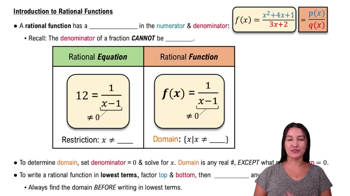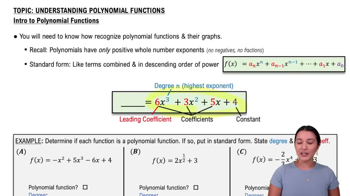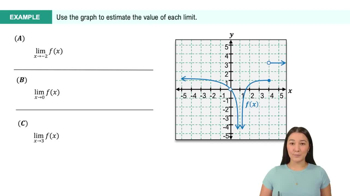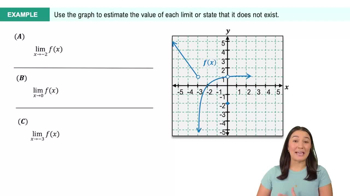Table of contents
- 0. Functions7h 52m
- Introduction to Functions16m
- Piecewise Functions10m
- Properties of Functions9m
- Common Functions1h 8m
- Transformations5m
- Combining Functions27m
- Exponent rules32m
- Exponential Functions28m
- Logarithmic Functions24m
- Properties of Logarithms34m
- Exponential & Logarithmic Equations35m
- Introduction to Trigonometric Functions38m
- Graphs of Trigonometric Functions44m
- Trigonometric Identities47m
- Inverse Trigonometric Functions48m
- 1. Limits and Continuity2h 2m
- 2. Intro to Derivatives1h 33m
- 3. Techniques of Differentiation3h 18m
- 4. Applications of Derivatives2h 38m
- 5. Graphical Applications of Derivatives6h 2m
- 6. Derivatives of Inverse, Exponential, & Logarithmic Functions2h 37m
- 7. Antiderivatives & Indefinite Integrals1h 26m
- 8. Definite Integrals4h 44m
- 9. Graphical Applications of Integrals2h 27m
- 10. Physics Applications of Integrals 2h 22m
1. Limits and Continuity
Introduction to Limits
Problem 2.4.59
Textbook Question
Use analytical methods and/or a graphing utility to identify the vertical asymptotes (if any) of the following functions.
f(x)=x^2−3x+2 / x^10−x^9
 Verified step by step guidance
Verified step by step guidance1
Step 1: Identify the function's denominator, which is \( x^{10} - x^9 \). Set the denominator equal to zero to find the values of \( x \) that make the function undefined: \( x^{10} - x^9 = 0 \).
Step 2: Factor the denominator. Notice that \( x^{10} - x^9 \) can be factored as \( x^9(x - 1) = 0 \).
Step 3: Solve the factored equation \( x^9(x - 1) = 0 \) to find the critical points. This gives \( x^9 = 0 \) and \( x - 1 = 0 \).
Step 4: Solve \( x^9 = 0 \) to find \( x = 0 \). Solve \( x - 1 = 0 \) to find \( x = 1 \). These are the potential vertical asymptotes.
Step 5: Verify if these points are indeed vertical asymptotes by checking the behavior of the function as \( x \) approaches these values. Since the numerator \( x^2 - 3x + 2 \) does not have \( x = 0 \) or \( x = 1 \) as roots, both \( x = 0 \) and \( x = 1 \) are vertical asymptotes.
 Verified video answer for a similar problem:
Verified video answer for a similar problem:This video solution was recommended by our tutors as helpful for the problem above
Video duration:
3mPlay a video:
Was this helpful?
Key Concepts
Here are the essential concepts you must grasp in order to answer the question correctly.
Vertical Asymptotes
Vertical asymptotes occur in a function when the output approaches infinity as the input approaches a certain value. This typically happens at values of x that make the denominator of a rational function equal to zero, provided that the numerator does not also equal zero at those points. Identifying these points is crucial for understanding the behavior of the function near those values.
Recommended video:

Introduction to Cotangent Graph Example 1
Rational Functions
A rational function is a function that can be expressed as the ratio of two polynomials. In the given function f(x) = (x^2 - 3x + 2) / (x^10 - x^9), the numerator and denominator are both polynomials. Analyzing rational functions involves understanding how the degrees of the polynomials affect the function's behavior, particularly in terms of asymptotes and intercepts.
Recommended video:

Intro to Rational Functions
Factoring Polynomials
Factoring polynomials is the process of breaking down a polynomial into simpler components, or factors, that can be multiplied together to yield the original polynomial. This is essential for identifying the roots of the numerator and denominator in rational functions, which helps in determining vertical asymptotes and simplifying the function for analysis.
Recommended video:

Introduction to Polynomial Functions

 6:47m
6:47mWatch next
Master Finding Limits Numerically and Graphically with a bite sized video explanation from Callie
Start learning





